WARNING: Graphic content.
The Criminal Code of Canada defines first degree murder as acts that were planned and deliberate. The Code also provides that “irrespective of whether a murder is planned and deliberate on the part of any person, murder is first degree murder in respect of a person when the death is caused by that person while committing or attempting to commit an offence under…” various sections including section 279 where kidnapping or confinement results in death.
It was on the strength of confinement and the nature of Wesley Hallam’s killing that Sault Ste. Marie Police laid the charge of first degree murder, as well as indignity to a human body, against Ronald Mitchell, Eric Mearow and Dylan Jocko.
Wesley Hallam was killed, decapitated and dismembered at a house party in Sault Ste. Marie, Ontario on January 7/8th, 2011. His body was discovered in Cold Water Creek on January 11th, 2011. His head, one foot and one hand were discovered in a dump in Dafter, Michigan in March 2011.
After a police investigation that involved about 200 officers, 200 witnesses, 90,000 pages of case brief that included video, and after perhaps the lengthiest preliminary hearing in Canadian history –to the tune of 3 million dollars plus, a backroom style deal was executed. On April 21st, 2016 John Luczak -director of Crown operations for the north region, Paul McDermott- Toronto Crown Attorney, Susan Stothart –Sudbury Crown Attorney, Dan Mitchell –Thunder Bay Crown Attorney and Kelly Weeks –Sault Ste. Marie Crown Attorney, cast a vote to accept a plea of manslaughter, ten years including time served. The reason given for accepting this plea was that the three men were impaired by drugs and alcohol and therefore deprived of self-control.
Witnesses and one co-accused –Dylan Jocko, testified to using drugs and alcohol that evening. Situations where an accused individual makes an admission of using alcohol or drugs may be self-serving to achieve a reduced charge.
In cases where alcohol and drugs have been consumed by an accused, murder charges may be reduced to manslaughter but not necessarily. There were no medical records demonstrating the co-accused’s toxicology in the late hours of January 7th and early hours of January 8th submitted into evidence because Mitchell et al were arrested much after the incident. It is unknown how much alcohol or other substances were in their system at the time they killed, decapitated and dismembered Wesley Hallam. What is known of the three men is that they all have criminal records and a history of violence.
Sault Ste. Marie Police did not learn of the deal until sometime in July 2016 when police transporting Mitchell, Jocko and Mearow to and fro court appearances overheard their chatter in the paddy wagon, where the three men openly spoke of the plea bargain. Upon confirming the information with the Crown, local authorities pressed the Crown to inform Wesley Hallam’s family and witnesses of the decision and the Crown did so two weeks prior to presenting the plea before the Court on July 28th, 2016.
On July 28th, 2016, before a courtroom of about 60 members of the public, Justice I.S. McMillan accepted the plea bargain. Mitchell, Mearow and Jocko will be released in about two years and will be eligible for parole in March 2017. The family was devastated, the community outraged and the Sault Ste. Marie Chief of Police is calling for a third party investigation into how such a miscarriage of justice could be permitted.
In accepting the plea bargain of manslaughter, McMillan was informed by an Agreed Statement of Facts. An Agreed Statement of Facts is a statement of facts that the defense counsel and Crown agree to be true. The 20 page Agreed Statement of Facts on the matter of Mitchell, Mearow and Jocko can be found at the end of this article. On August 25, 2016 Justice McMillan read his reasons for his sentencing into record setting off a new wave of righteous anger among the community.
Understanding the frustration of the Sault Ste. Marie Police and the injustice felt by Wesley Hallam’s family as well as others who were present throughout the three and a half year preliminary hearing, requires us to look at what didn’t make it into the Agreed Statement of Facts.
*****
Editor’s Note: At a minimum of .55 cents per page –typed or electronic, acquiring a transcript of the Mitchell et al preliminary hearing is hardly accessible. If what you’re looking for isn’t typed yet, be prepared to spend $4.30 per page.
The preliminary hearing for Mitchell et al began in October 2012. Several witnesses were young people who had been present at the house party when Wesley was killed and dismembered. Points 24 to 28 in the Agreed Statement of Facts (below) provide an account of those events. However, some evidence that was provided by those witnesses never made it into the Agreed Statement of Facts.
The information below was gathered from evidence presented in the preliminary hearing spanning three and a half years the old fashion way- note taking.
According to the testimony of Constable Sonny Spina on January 30th, 2013 Jocko was the only man of the three accused that provided a statement to the police about the events surrounding Wesley Hallam’s death.
On March 14th, 2013, about six months into the preliminary hearing, OPP Detective-Inspector James Smyth was questioned by Dylan Jocko’s defense counsel, Bruce Willson. Many portions of Jocko’s videotaped statements were presented in the preliminary hearing. Smyth agreed that Jocko did not commit the fatal injury to Wesley but that Jocko’s admissions indicated he was culpable of 1st degree murder. In his statements to the police, Jocko admitted his role -assault, confinement and handling tools to dismember Wesley.
“Confinement in addition to the circumstances of Wesley’s murder would make Jocko indictable of 1st degree murder,” remarked Smyth from the witness stand.
Smyth also pointed out that other witnesses had stated that Hallam had been confined for a period of time in the washroom and begging for his life.
On January 21st and 22nd, 2013 Dr. Scott I. Fairgrieve and Dr. Martin Queen appeared on the witness stand to provide their testimony regarding their separate post-mortems on Wesley’s body, head and recovered remains. Noted were significant defense wounds to Wesley’s left arm. Thirty-five incised linear marks created by a blade drawn across the arm with force were identified- 11 impressions to the ulna, 24 to the radius. A large wound was identified on Wesley’s right forearm –an opening in the flesh that proceeded to the bone located just below Wesley’s tattoo. Injuries also included scratches, blunt force trauma, 1 stab wound to the right shoulder and 1 stab wound to the lateral right clavicle, injuries above the left buttock and mid back that Dr. Queen explained was likely due to dragging. Dr. Queen stated that almost all of Wesley’s major blood vessels were exsanguinated and that lack of blood flow to the sever points on the neck, wrists and ankles suggested that Wesley had passed when dismemberment and decapitation occurred.
The extreme blood loss, almost 5 litres, was the result of 2 fatal stab wounds to the neck that severed the carotid artery and jugular vein. Wesley’s head presented 6 other stab wounds- 5 to the head and one to the neck,that were not life-threatening. Witness accounts put those 2 lethal injuries at the tip of Ron Mitchell’s blade. But witnesses in the bedroom where Wesley met his ultimate demise did not observe the excessive behaviour that resulted in these additional stab wounds to the head and neck or the defensive wounds.
The post-mortems conducted by Dr. Fairgrieve and Dr. Queen led the doctors to believe that two knives were used on Wesley- a single bladed knife and a double bladed knife.
Post-mortem also indicates that two blades were used in the attack against Wesley but the Agreed Statement of Facts acknowledges only two fatal stab wounds and attributes those injuries to Mitchell. The Agreed Statement of Facts also omits Wesley Hallam’s defensive wounds as well as his pleas for his life and confinement by the three co-accused as reported by witnesses.
Two key witnesses who observed the fatal fight in the bedroom (points 22- 29) recalled the incident began with a verbal disagreement that escalated. Hallam shoved Mitchell and a fight ensued. Mearow, now in the bedroom upon hearing the commotion kicked the men apart. Jocko was standing behind Mearow. Hallam pulled out his knife and then Mitchell pulled out his. Hallam and Mitchell began swinging their knives. Jocko joined in and helped out Mitchell. The two wrested the knife out of Hallam’s grasp. The knife hit the floor and the blade dropped out of its’ hilt. Hallam was unarmed. Mearow joined in the group assault- three men against Hallam.
Two of the witnesses observed Mitchell stab Wesley twice. One of the witnesses fled the room. The second witness would soon follow. Said the second witness, “Ronnie stabbed him once and then took a second swing at Wes’s head. Wes was trying to scoot backwards. His legs were straight out and it looked like he couldn’t move his legs. He was moving backwards, slouched over, using his hands to move backwards.”
Another witness entered the room upon hearing the fight, where she discovered Wesley on the ground and that blood was “everywhere”. At this time Mearow leaves the bedroom and orders the partiers to not go anywhere. Many of the witnesses admitted that they obeyed the order because they were scared. The witness brings Wesley a towel to apply to his injuries and screamed for an ambulance. Mearow returns to the bedroom and tells the witness to ‘shut-up’. Wesley asked for a beer and a smoke. The witness goes into the next room to get Wesley a cigarette when another scuffle broke out. From the next room she observed the three co-accused were forcing Wesley to the bathroom.
“Wes was screaming ‘please bro’. Wes was screaming ‘please bro stop, please don’t’.” The witness observed all three men “pushing him”. “He was on his feet being lifted up, he was trying to push back. The three were saying ‘put him in the bathtub’. He screamed more than once.”
Frightened she ran down the stairs.
When I got to the bottom of the stairs I couldn’t hear him anymore.”
Downstairs other witnesses heard Wesley begging for his life.
In his expert testimony, Dr. Queen remarked of the stabs through the carotid artery and jugular vein that a person with these injuries would be relatively conscious and could run, fight or yell for a period of time and stated, “An educated guess is a person could live in the single or low double minutes” and “With this type of injury heroic efforts are pretty futile”.
So what of the other forty plus stab wounds suffered by Wesley Hallam?
Dr. Queen said of the defense wounds on Wesley’s arms that the injuries appeared to have occurred perimortem or close to death. Dr. Fairgrieve noted in his testimony that a wound on Wesley’s skull above the left ear was perimortem- “around the time of death”.
The video statements of Dylan Jocko and testimony from Ron Mitchell’s mother, suggests that Eric Mearow wielded the second knife in the attack on Wesley Hallam.
On January 16, 2013 Mitchell’s mother took the witness stand. The Crown pressed her memory of a conversation with her son following his arrest in Hallam’s death. She testified on the witness stand, “He said that he and Wes got into a fight and they were swinging knives. He said he might have nicked him beneath the ear and I said ‘oh my God that’s where the jugular is’. He said it was ‘ok and it was all over’. And he said Eric said ‘oh no it isn’t’ and kicked the door shut and started to stab Wesley over and over again. He said he fell to his knees and Eric told him to get it together or he would look like Wes too. He said he had to guard the bathroom and make sure that no one went in it. He said he was scared for his life and said he did what he had to, to keep us all safe.”
On January 23rd, 2013 defense for Dylan Jocko entered Jocko’s videoed statement to the police as evidence in the preliminary hearing. The interview was taped on January 30th, 2011. On the tape Jocko stated as he wept, “Wes’s knife broke. Eric pulled out another knife. Eric was fighting with Wes, got over him in the hallway and stabbed him in the head.”
Jocko later added in his videoed statement to police, “Eric was making us do things. He was making us involved. He was walking around the house holding a chisel in one hand and a hammer in the other hand”, and “I felt like a f*ckin’ hostage”.
On May 6th, 2013, Crown Attorney Kelly Weeks presented a Summation of Evidence before Justice Andrew Buttazzoni. In her summation she made several statements that justified the charge of 1st degree murder as well as indignity to a human body. Her statements included:
- All three men were in the bedroom.
- All three men dragged him to the bathroom
- All three men were in the bathroom
- Melissa Elkin [witness as well as charged and convicted of obstruction of justice]heard Wes ask for help and Mearow said ‘no help for you’ and slit Wesley Hallams throat. Mitchell and Jocko stood by.
- All three men prevented people from going to help Wes.
- All three men wouldn’t let Wes leave.
- All three men ignored Wes’s plea for his life.
- Nobody saw the three men out of the bathroom until after Wes went silent.
- All three men took turns with the decapitation.
On this last point, testimony from Dr. Fairgrieve provided that a mechanical saw was used to remove Wesley’s head and that the nature of the damage indicates the head was being moved while the saw was pivoting.
On October 28th, 2013 Justice Andrew Buttazzoni ruled that the charges of 1st degree murder held up reading in his decision that:
- All three men conceded to interference with a dead body.
- That the three co-accused could have acted as co-principals, there were inferences of joint effort and domination of Wesley Hallam from the first blow to death.
Buttazzoni further added that the charges of 1st degree murder were appropriate on the following points:
- Reasonable inference that the fatal wound was struck in the bedroom
- The three co-accused dragged him to the bathroom
- Information from the witnesses provided that Hallam was confined
Buttazzoni remarked, “…a jury could make an inference on 1st degree murder for all three men.”
To the reader, you can be sure that the entire truth of Wesley Hallam’s murder has yet to be told.
*****
Editor’s Note: Point 19 of the Agreed Statement of Facts presents as an assembly of opinions serving to discredit the victim, Wesley Hallam. Added to that is some confusion as to how these ‘facts’ were gathered given that neither Ronald Mitchell nor Eric Mearow offered a statement to the police –as noted above. Witnesses presenting testimony at the preliminary hearing testified that Wesley Hallam and a witness had spoken on the evening of January7/8th, 2011. Wesley offered the witness an apology and the two hugged. The mention of Jacquilynne Gray is peculiar. Jacquilynne, now deceased, had been the victim of a brutal attack. Wesley was present at the time and before the court on her own matter, Jacquilynne admitted that it was because of Wesley that she was alive. She testified that her assailants were talking about putting her in a bathtub and letting her bleed out.
*The names of some of the witnesses in the statement below have been redacted. The names of the accused, persons charged and sentenced, and professionals involved in the preliminary hearing have been left untouched.
AGREED STATEMENT OF FACTS

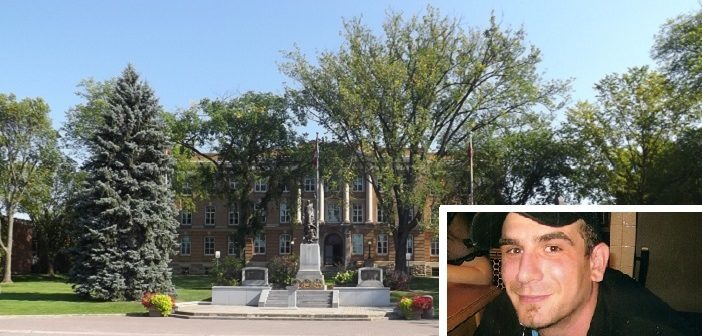

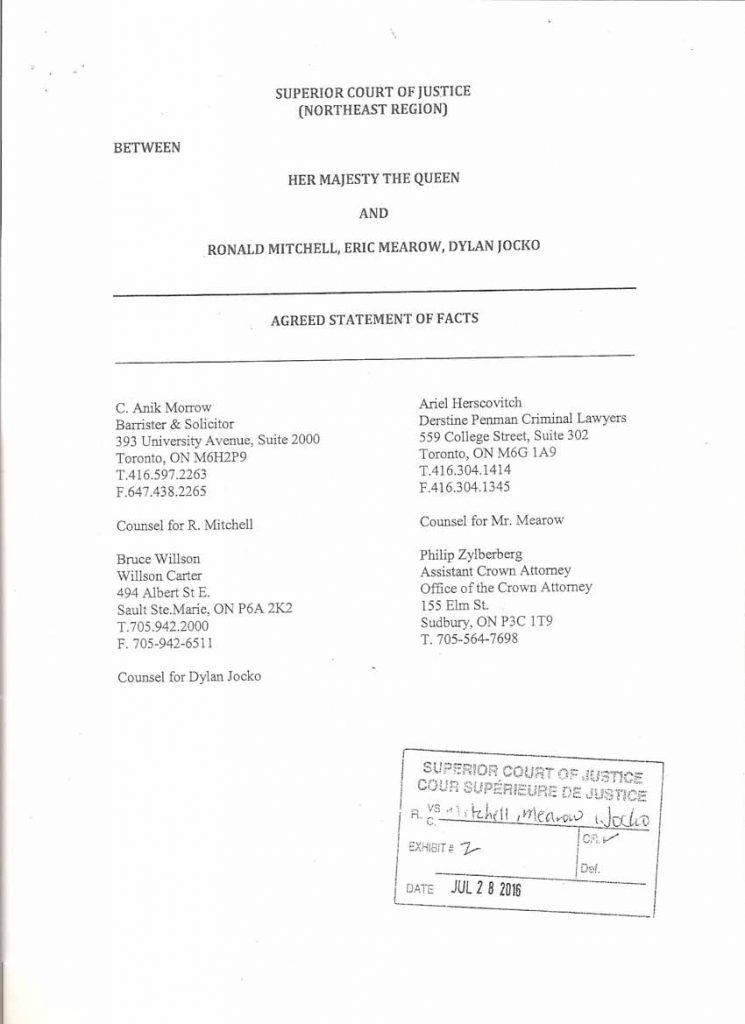
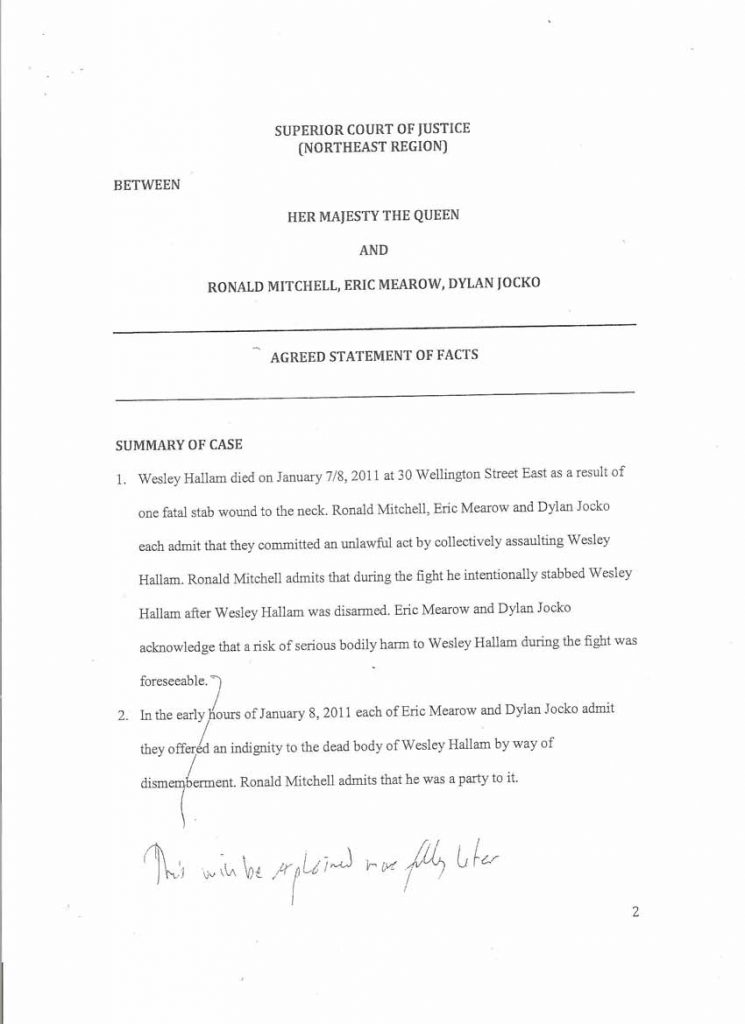
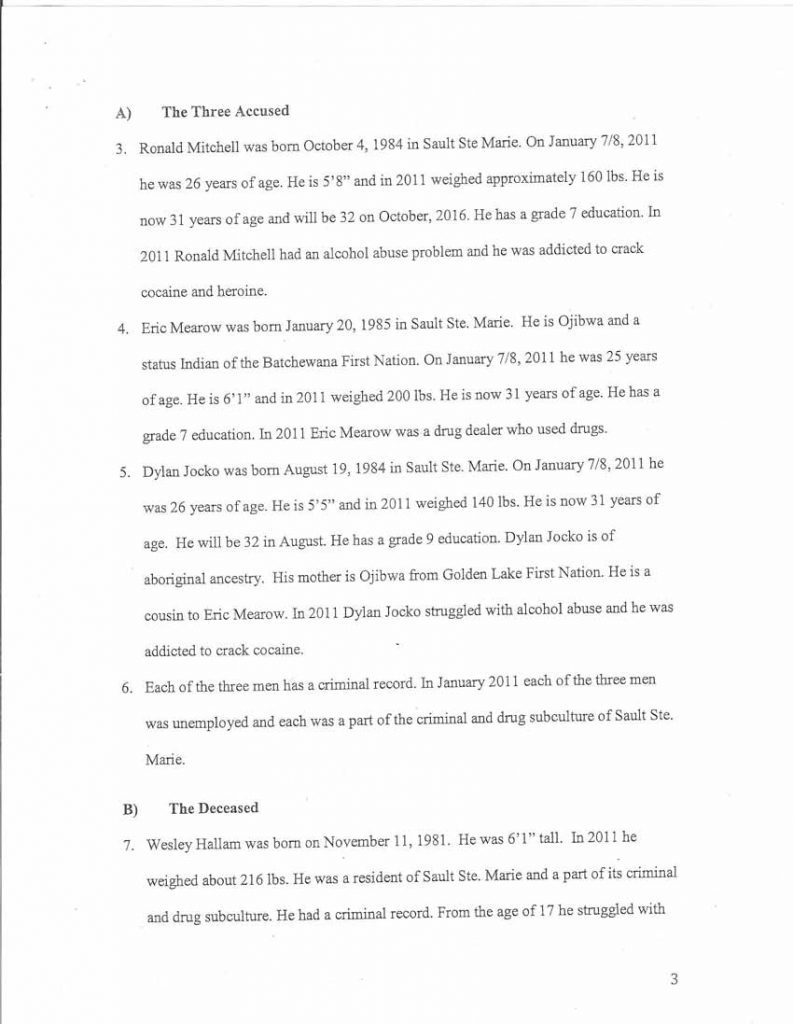
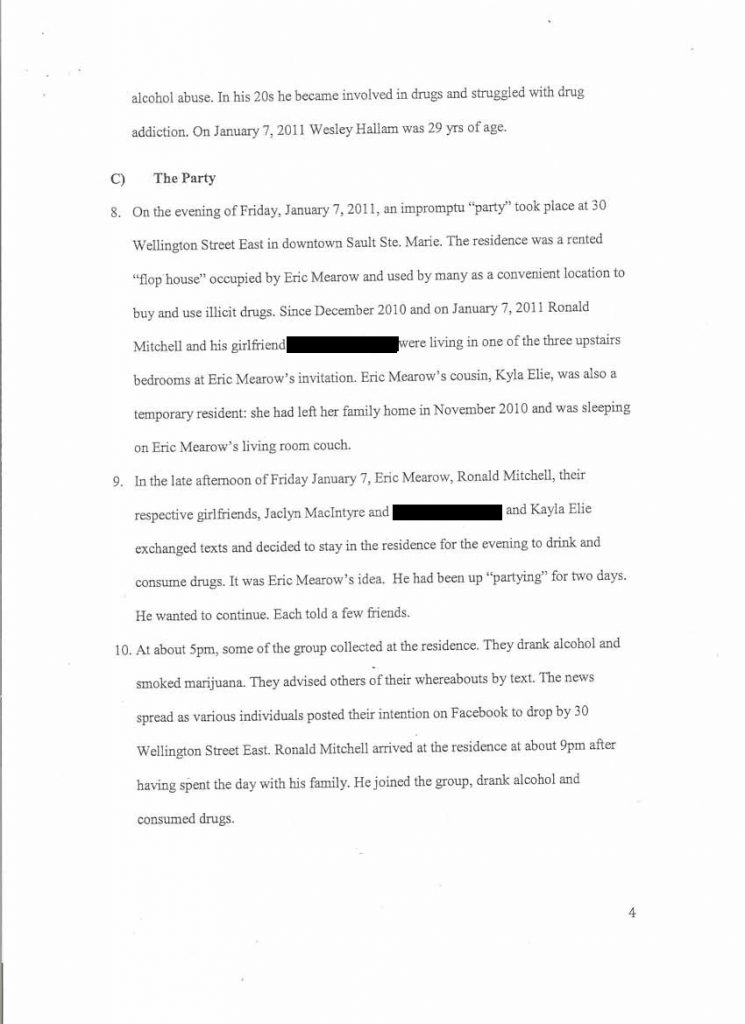
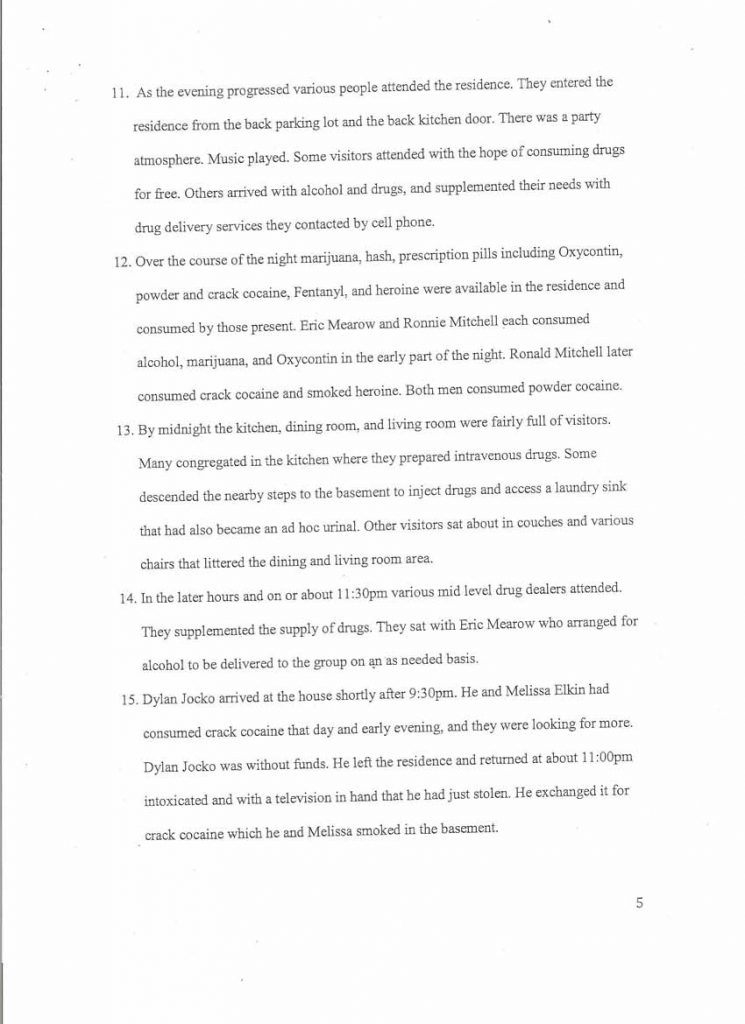
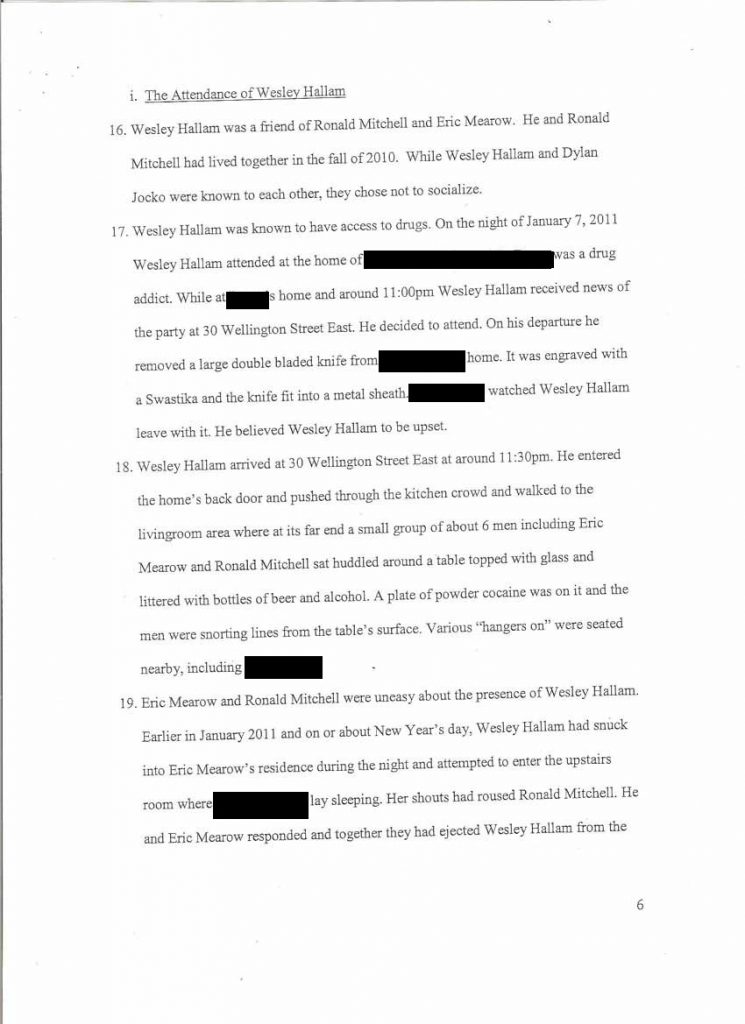
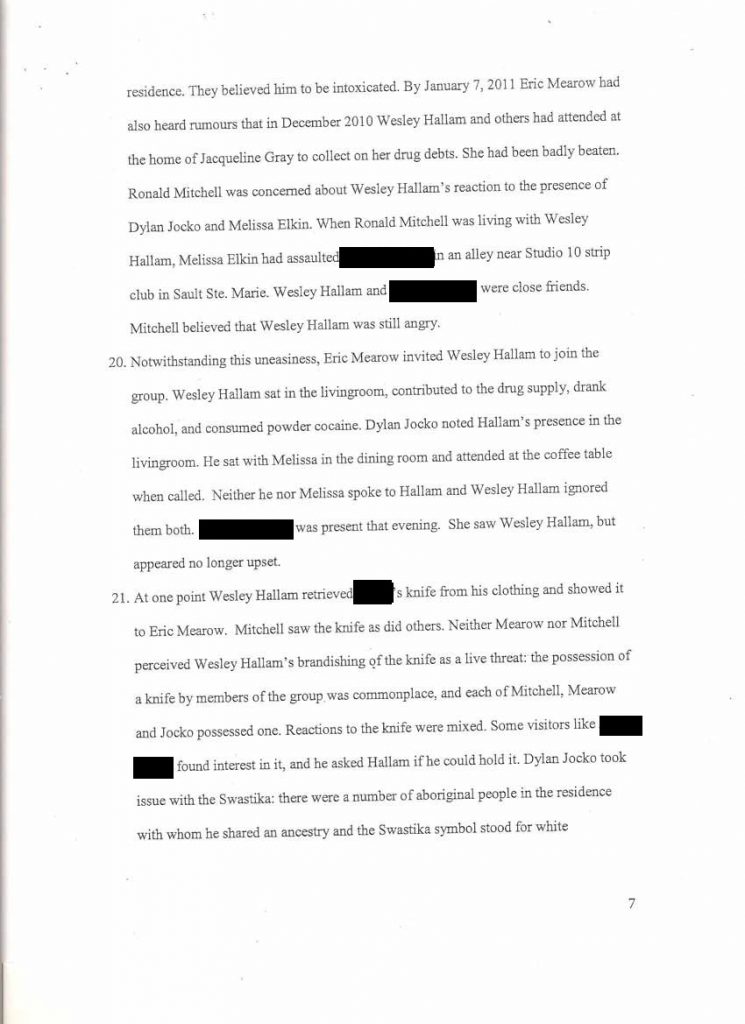
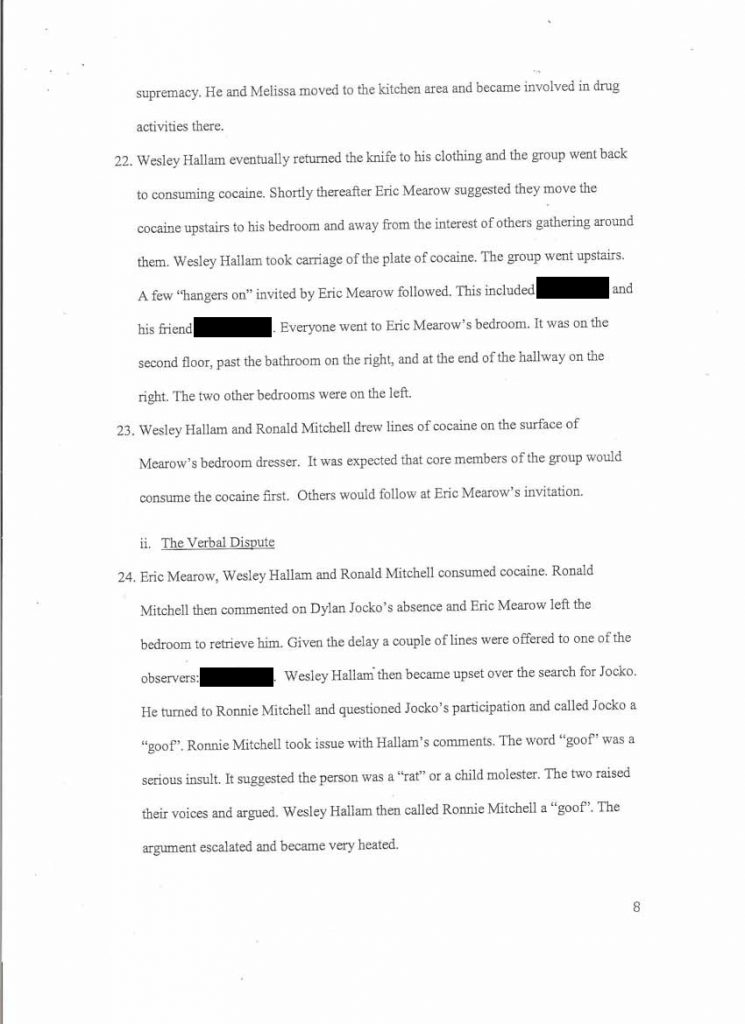
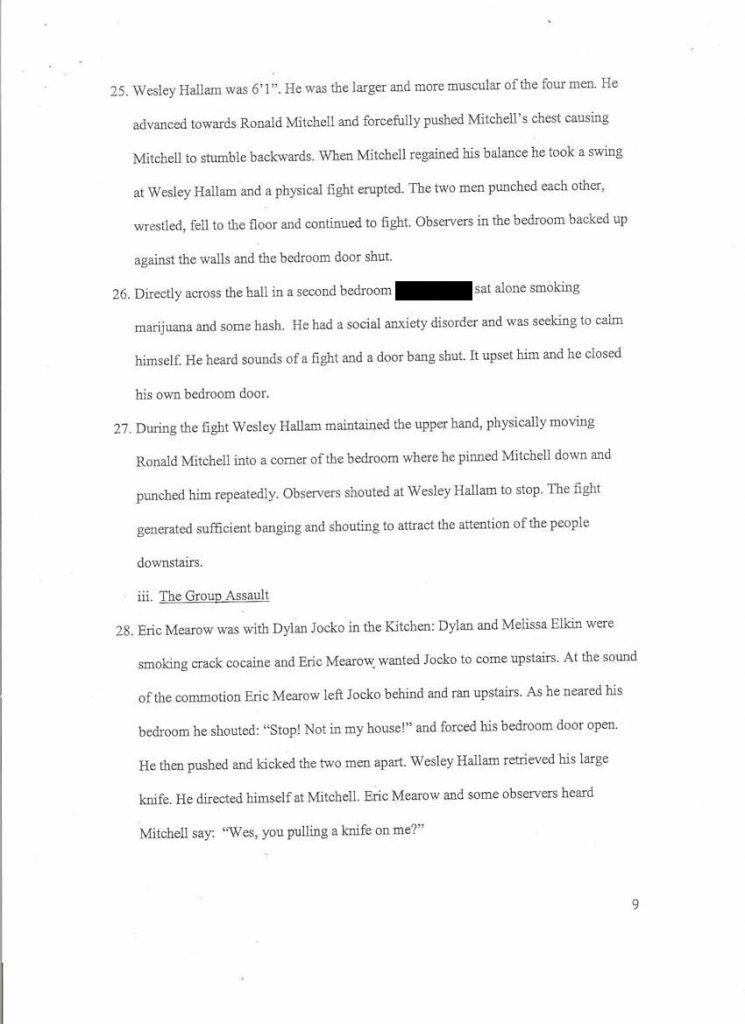
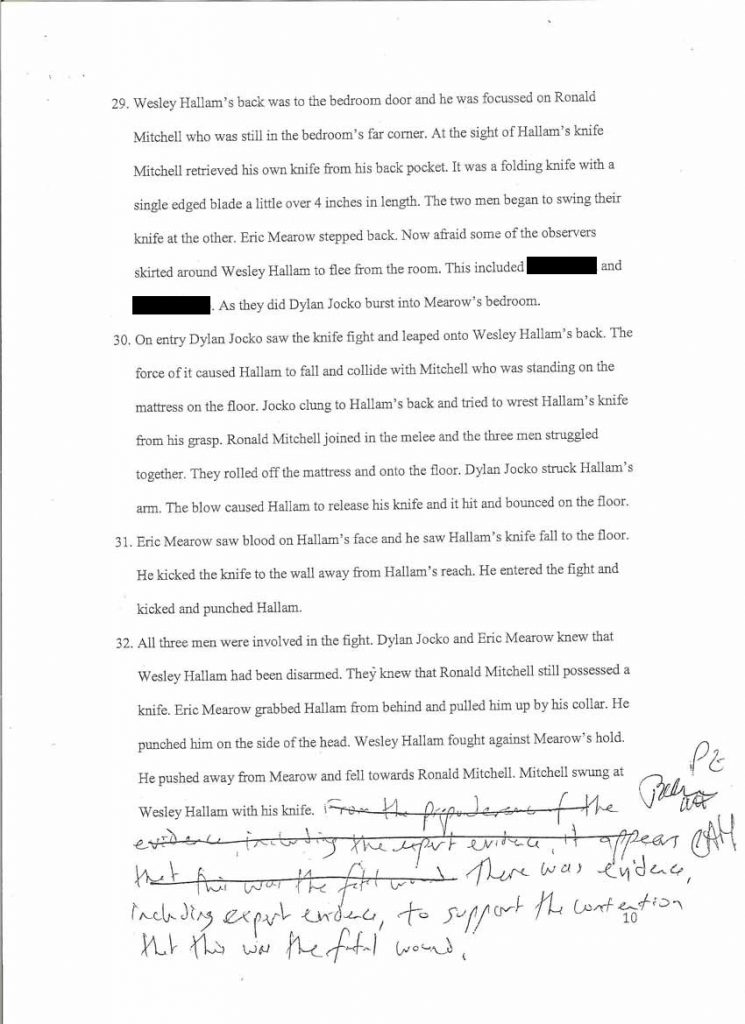
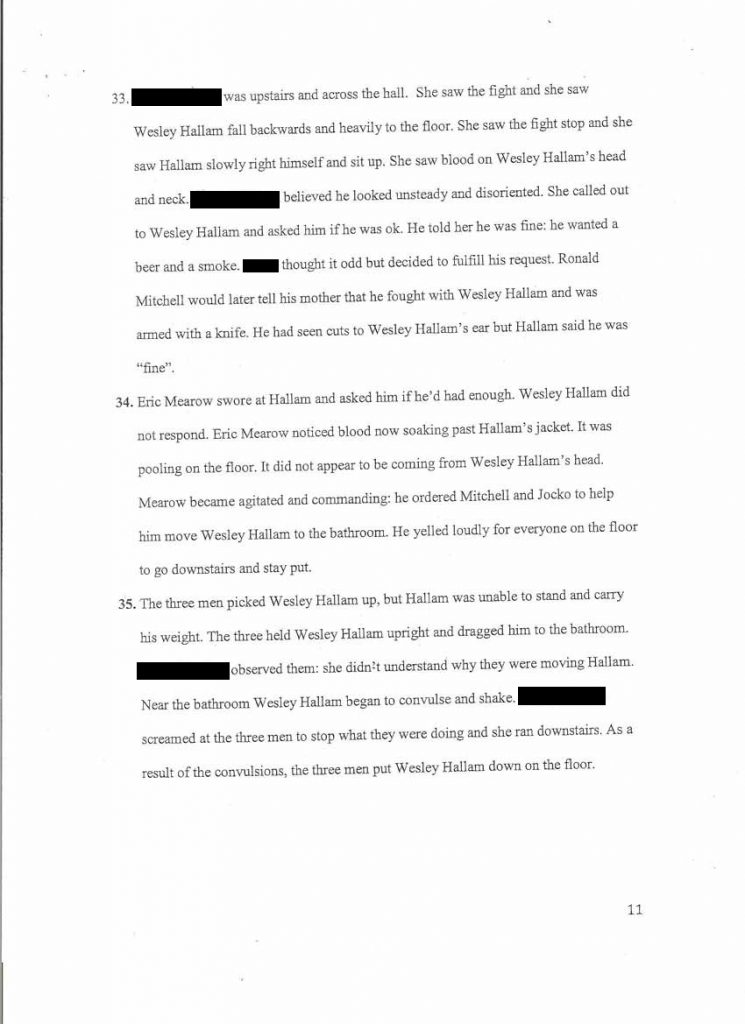
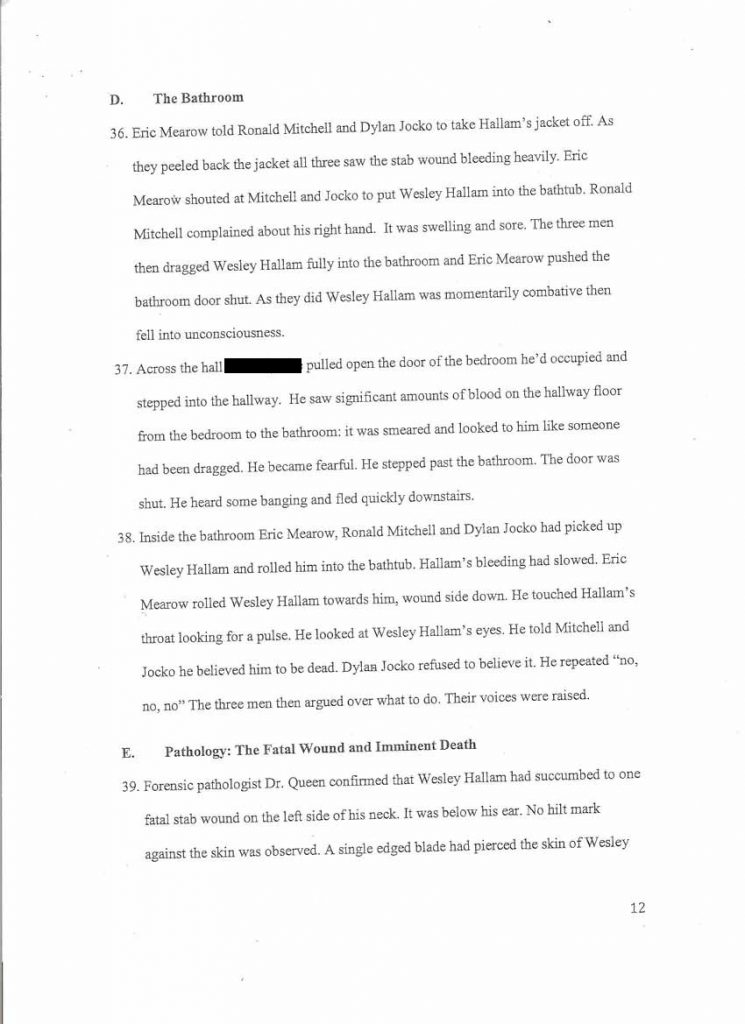
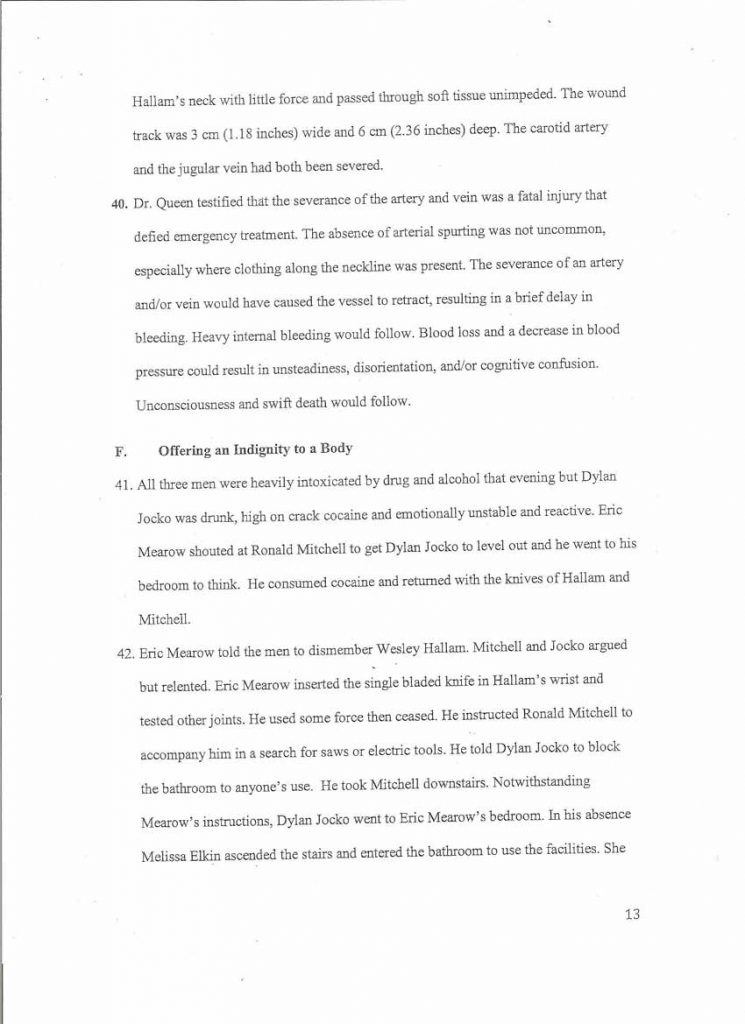
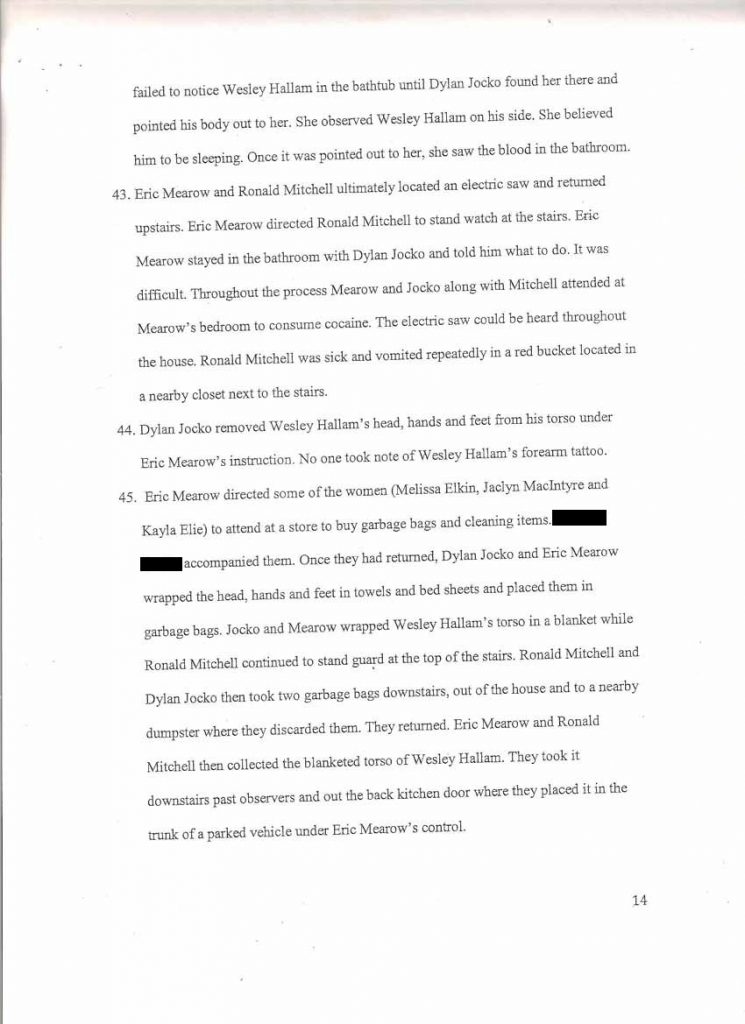
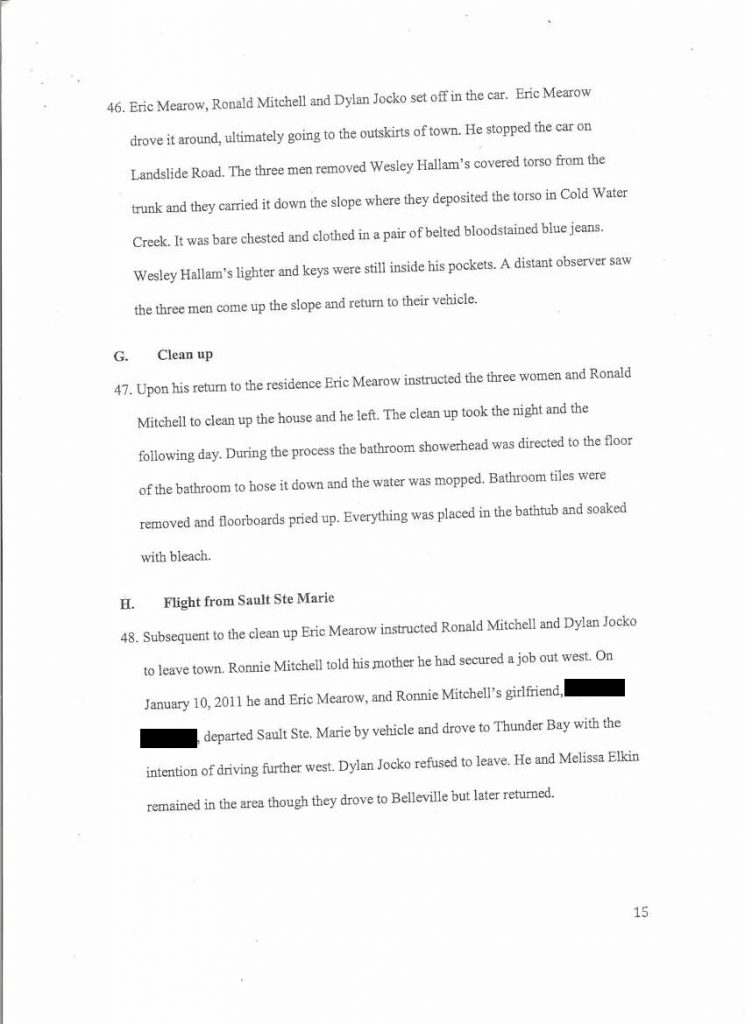
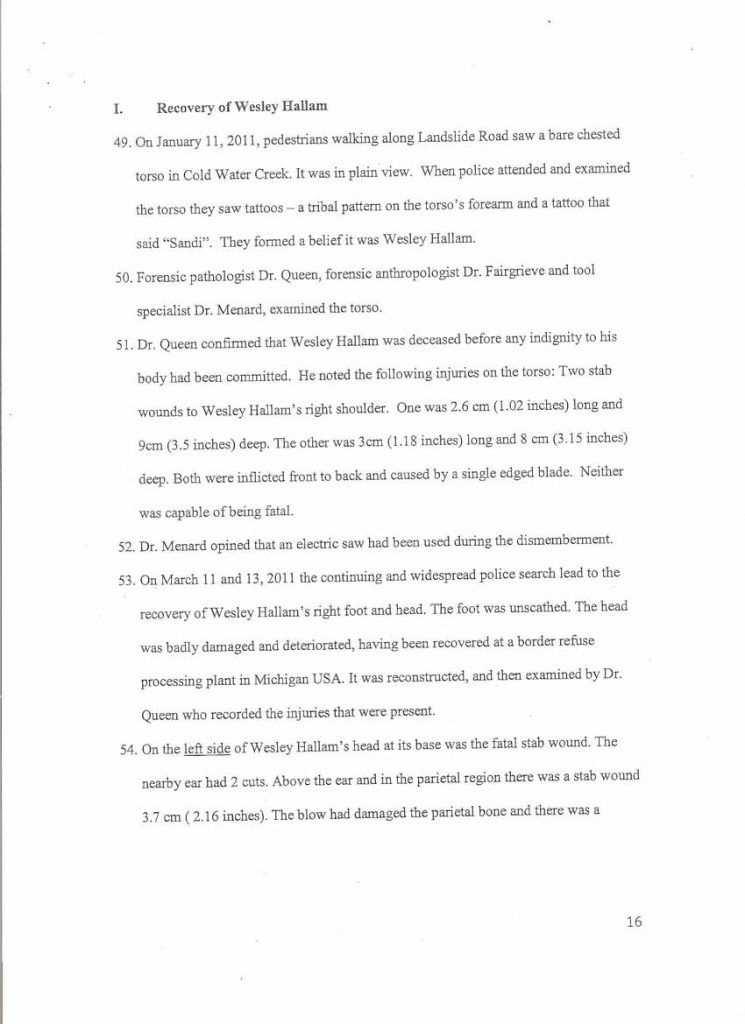
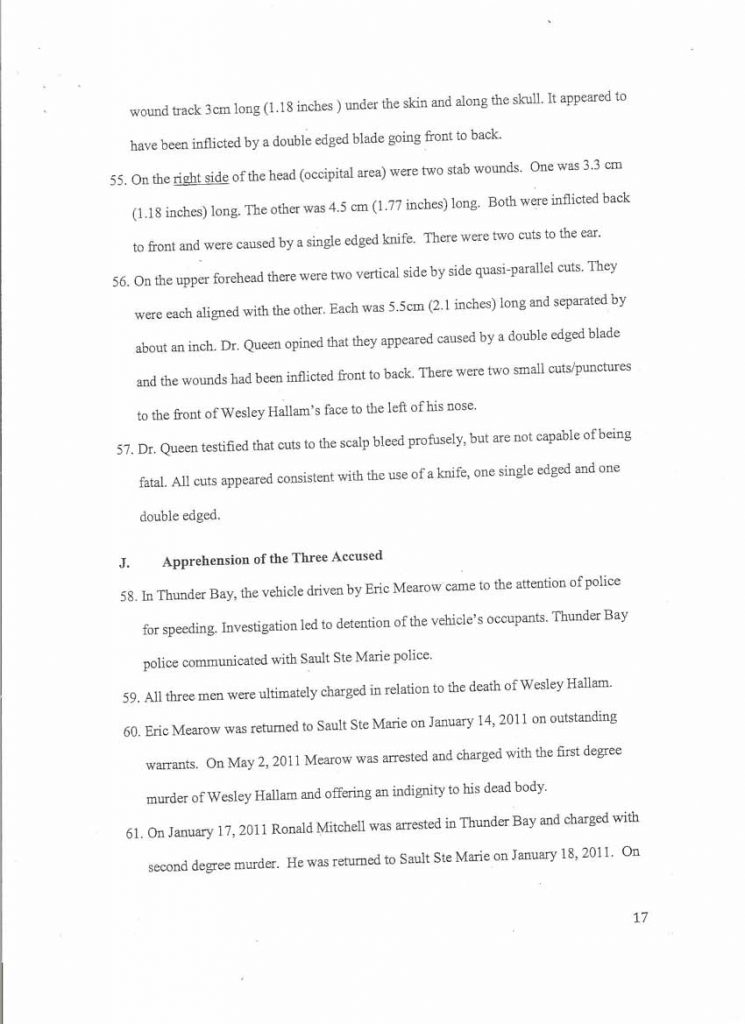
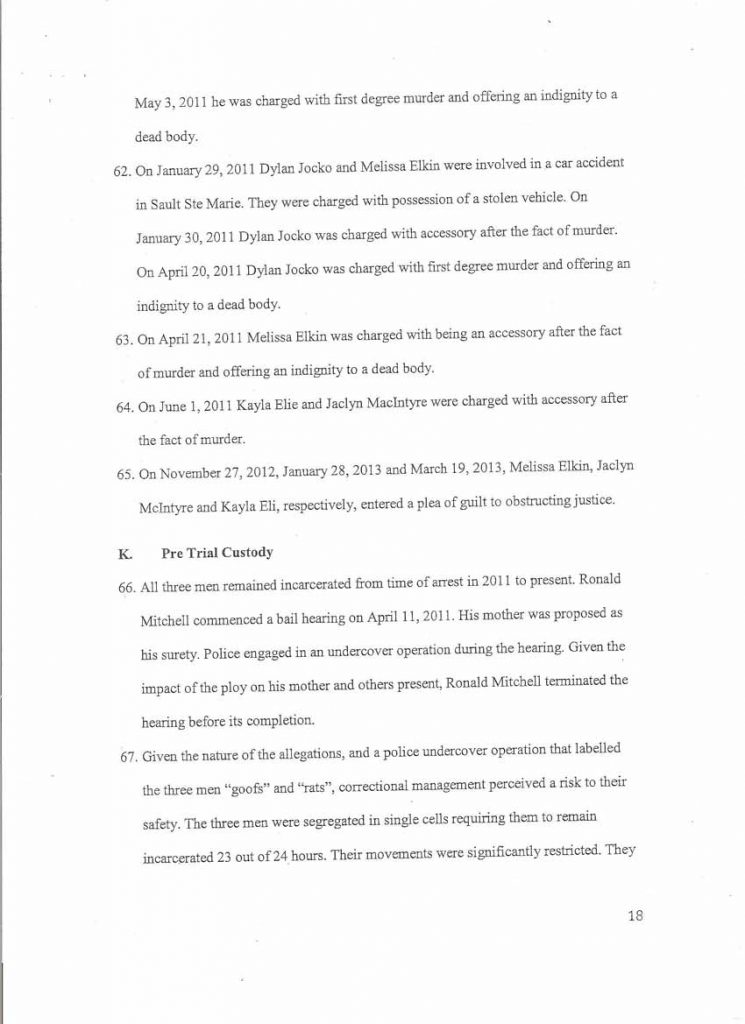
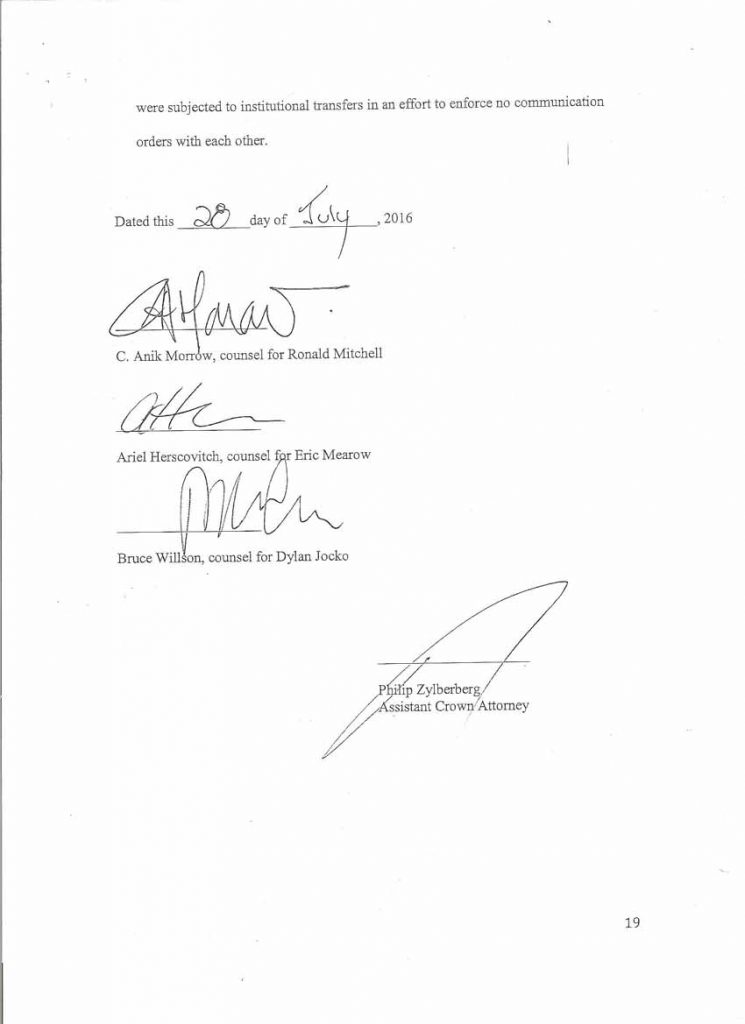
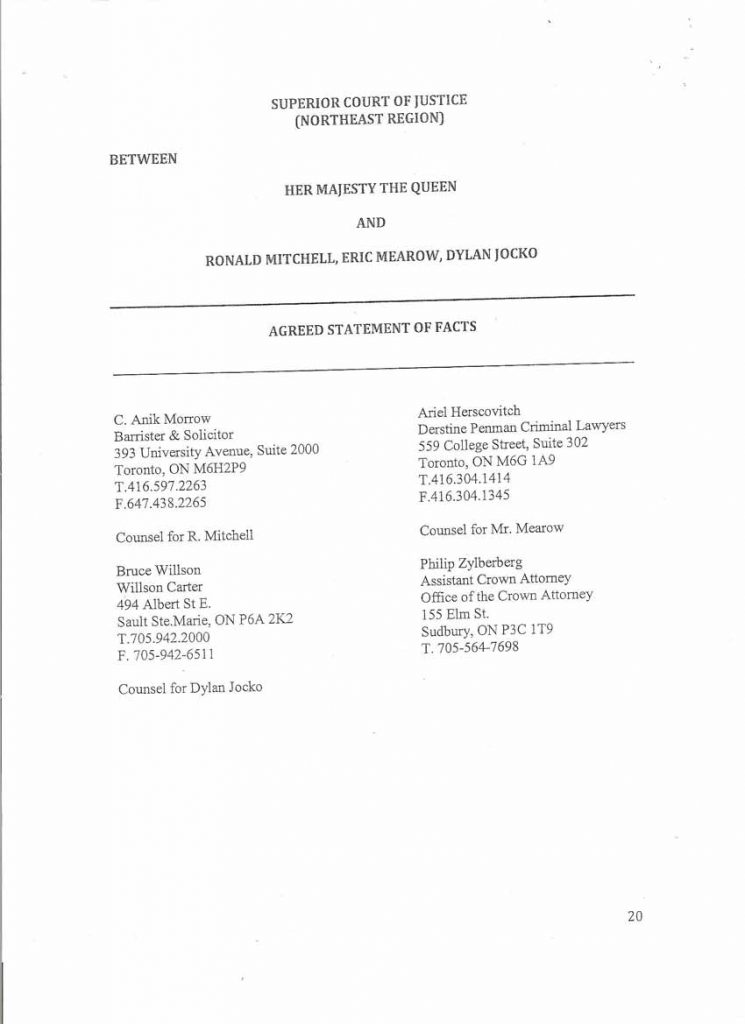
6 Comments
So the Crown states that they could not expect a jury to find these three guilty of 1st or 2nd degree murder due to the level of intoxication, yet these three were able to carry out a murder and then the grisly attempt to conceal it. The Crown appears to have little to no faith in the jury system. It comes across as the Crown simply not caring about drug users killing drug users, the question I have is if Wes Hallam was from a prominent family with influence and money would this ridiculous plea bargain have been struck.
My brother was so much more than a drug user . I wish people would stop attacking him . The matter in which he died he does not deserve this . Drug user or not he was a human being .He was not the one on trial
Shannon, please do not take my comment about drug use as being an attack in any manner on your brother. It is definitely not intended to suggest that your brother was not loved and respected by family that knew him.
My comment is directed at how the Crown to me comes across as not doing the job it should have done and using the drug use involved as its reasoning. No human being should have to have their life end in this manner and then not have proper justice served.
the point that everyone seems to miss is that EVERYONE in that house was under the influence – making all of their account of fact un creditable – even with people who are not under the influence they never have the same account of what happened. Everyone invloved had a reason to lie
I guess the Dr or pathologist lies too right…go away for once Lori I have been dealing with you for far too long
Lori Richer….you really don’t know what you are talking about. Physical evidence can corroborate witness testimony and in fact makes witness testimony credible. Even witnesses under the influence of drugs or alcohol can remember events, especially events that are as shocking to witness as this would have been. There were also enough witnesses to testify which helped investigators in putting together the events that unfolded.
You certainly should realize that many crimes that are committed are done so while the perpetrators and witnesses have been under the influence. As you pointed out when people witness an event they do not have the exact same account of what happened, this in itself signals to investigators that there has not been a collaboration of the ‘same story’. The details that were provided in the preliminary testimony by witnesses, along with all of the physical evidence were certainly enough to evoke high confidence within the police department as to credibility. So unfortunate that the Crown did not follow through.